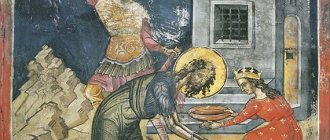The Scriptures of the New Testament were written in Greek, with the exception of the Gospel of Matthew, which, according to tradition, was written in Hebrew or Aramaic. But since this Hebrew text has not survived, the Greek text is considered the original for the Gospel of Matthew. Thus, only the Greek text of the New Testament is the original, and numerous editions in various modern languages around the world are translations from the Greek original. The Greek language in which the New Testament was written was no longer the classical ancient Greek language and was not, as previously thought, special New Testament language. It is a spoken, everyday language of the 1st century. according to PX, spread throughout the world and known in science under the name “common dialect,” yet both the style and turns of speech, and the way of thinking of the sacred writers of the New Testament reveal Hebrew or Aramaic influence.
The original text of the New Testament has reached us in a large number of ancient manuscripts, more or less complete, numbering about 5000 (from the 2nd to the 16th centuries). Until recent years, the most ancient of them did not go back further than the 4th century. by PX But recently many fragments of ancient manuscripts of the New Testament on papyrus (III and even II centuries) have been discovered. For example, Bodmer's manuscripts: John, Luke, 1 and 2 Pet, Jude - were found and published in the early years of the 20th century. In addition to Greek manuscripts, we have ancient translations or versions in Latin, Syriac, Coptic and other languages (Vetus Itala, Peshitto, Vulgata, etc.), of which the most ancient existed already from the 2nd century to the 9th century
Finally, numerous quotes from the Church Fathers have been preserved in Greek and other languages in such quantities that if the text of the New Testament were lost and all the ancient manuscripts were destroyed, then experts could restore this text from quotes from the works of the Holy Fathers. All this abundant material makes it possible to check and clarify the text of the New Testament and classify its various forms (so-called textual criticism). Compared with any ancient author (Homer, Euripides, Aeschylus, Sophocles, Cornelius Nepos, Julius Caesar, Horace, Virgil, etc.), our modern - printed - Greek text of the New Testament is in an exceptionally favorable position. Both in terms of the number of manuscripts and the short period of time. separating the oldest of them from the original, and in the number of translations, and in their antiquity, and in the seriousness and volume of critical work carried out on the text, it surpasses all other texts (for details, see: “Hidden Treasures and New Life”, archaeological discoveries and the Gospel , Bruges, 1959, pp. 34 ff.).
The text of the New Testament as a whole is recorded completely irrefutably.
The New Testament consists of 27 books. The publishers have divided them into 260 chapters of unequal length for ease of reference and citation. This division is not present in the original text. The modern division into chapters in the New Testament, as in the whole Bible, has often been attributed to the Dominican Cardinal Hugo (1263), who worked it out while composing a symphony to the Latin Vulgate, but it is now thought with greater reason that the division goes back to the Archbishop of Canterbury, Stephen Langton, who died in 1228. As for the division into verses, now accepted in all editions of the New Testament, it goes back to the publisher of the Greek New Testament text, Robert Stephen, and was introduced by him into his edition in 1551.
The sacred books of the New Testament are usually divided into legal (Four Gospels), historical (Acts of the Apostles), teaching (seven conciliar epistles and fourteen epistles of the Apostle Paul) and prophetic: Apocalypse, or Revelation of St. John the Theologian (see Long Catechism of Metropolitan Philateer)
However, modern experts consider this distribution to be outdated: in fact, all the books of the New Testament are both legal and historical teaching, and prophecy is not only in the Apocalypse. New Testament scholarship pays great attention to the precise establishment of the chronology of the Gospels and other New Testament events. Scientific chronology allows the reader to trace with sufficient accuracy through the New Testament the life and ministry of our Lord Jesus Christ, the apostles and the primitive Church (see Appendices).
The books of the New Testament can be distributed as follows.
- Three so-called synoptic Gospels: Matthew, Mark, Luke and separately, the fourth is the Gospel of John. New Testament scholarship devotes much attention to the study of the relationships of the first three Gospels and their relation to the Gospel of John (synoptic problem).
- The Book of the Acts of the Apostles and the Epistles of the Apostle Paul ("Corpus Paulinum"), which are usually divided into: - Early Epistles: 1 and 2 Thessalonians; — Greater Epistles: Galatians, 1 and 2 Corinthians, Romans; - Messages from bonds, that is, written from Rome, where St. Paul was in prison: to the Philippians, to the Colossians, to the Ephesians, to Philimoi; — Pastoral Epistles: 1 to Timothy, to Titus, 2 to Timothy; — Epistle to the Hebrews;
- Council Epistles (“Corpus Catholicum”)
- Revelation of John the Theologian. (Sometimes in the New Testament they distinguish “Corpus Joannicum”, i.e. everything that Apostle John wrote for the comparative study of his Gospel in connection with his epistles and Rev.)
Four Gospels
- The word "gospel" in Greek means "good news." This is what our Lord Jesus Christ Himself called his teaching (Matthew 24:14; 26:13; Mark 1:15; 13:10; 19:; 16:15). Therefore, for us, the “gospel” is inextricably linked with Him: it is the “good news” of the salvation given to the world through the incarnate Son of God. Christ and His apostles preached the gospel without writing it down. By the mid-1st century, this preaching was established by the Church in a strong oral tradition. The Eastern custom of memorizing sayings, stories, and even large texts helped Christians of the apostolic era accurately preserve the unrecorded First Gospel. After the 50s, when eyewitnesses of Christ's earthly ministry began to pass away one after another, the need arose to write down the gospel (Luke 1:1). Thus, “gospel” came to mean the narrative of the Savior’s teaching recorded by the apostles. It was read at prayer meetings and in preparing people for baptism.
- The most important Christian centers of the 1st century. (Jerusalem, Antioch, Rome, Ephesus, etc.) had their own Gospels. Of these, only four (Matthew, Mark, Luke, John) are recognized by the Church as inspired, that is, written under the direct influence of the Holy Spirit. They are called “from Matthew”, “from Mark”, etc. (Greek kata corresponds to Russian “according to Matthew”, “according to Mark”, etc.), for the life and teachings of Christ are set out in these books by these four sacred writers. Their gospels were not compiled into one book, which made it possible to see the gospel story from different points of view. In the II century. St. Irenaeus of Lyons calls the evangelists by name and points to their gospels as the only canonical ones (Against heresies, 2, 28, 2). Contemporary of St. Irenaeus Tatian made the first attempt to create a single gospel narrative, composed of various texts from the four gospels, the Diatessaron, i.e., the “gospel of the four.”
- The apostles did not set out to create a historical work in the modern sense of the word. They sought to spread the teachings of Jesus Christ, helped people to believe in Him, to correctly understand and fulfill His commandments. The testimonies of the evangelists do not coincide in all details, which proves their independence from each other: the testimonies of eyewitnesses always have an individual coloring. The Holy Spirit does not certify the accuracy of the details of the facts described in the gospel, but the spiritual meaning contained in them. The minor contradictions found in the presentation of the evangelists are explained by the fact that God gave the sacred writers complete freedom in conveying certain specific facts in relation to different categories of listeners, which further emphasizes the unity of meaning and orientation of all four gospels.
New translation into Russian of the Gospel of Matthew
The new translation of the Gospel of Matthew does not satisfy the second of the requirements we have indicated, concerning the accurate transmission of the original.
Free deviations from the original and even distortions of its meaning in the translation are very numerous. They begin with the first words of the Gospel.
1– In the original Greek, the first words of the gospel read: Βίβλος γενέσεως; the Slavic text conveys: “book of kinship”; The Russian translation is close to the Slavic: “genealogy” (of Jesus Christ). The new translation offers a new reading: “the book of the birth” (of Jesus Christ), which is far from the original and does not correspond to the context, since what follows is the genealogy of Christ (See Interpretation of John Chrysostom - “The Works of our Holy Father John Chrysostom in the Russian translation ". T. VII. Book 1. St. Petersburg, 1911. SS. 26 et seq.).
1– “For He will save His people (τον λαόν) from their sins (αύτών).” The new translation reads: “For He will save His people from their sins.” This translation was recognized as incorrect in his time by Metropolitan Philaret of Moscow, who noted that salvation does not apply to the people en masse, but to people individually, which is expressed in the Greek plural:
αύτών (Works of Metropolitan Philaret of Moscow and Kolomna on the translation of the New Testament into Russian. St. Petersburg, 1893. P. 3).
1 – “will receive in the womb” (έξει) - this is how the Slavic and Russian synodal translations read. The new translation suggests: “he will conceive in the womb.” Metropolitan Philaret believed, and quite rightly, that the Synodal translation was more consistent with the original and with the sacrament: The Most Holy Virgin did not conceive the Beginningless, but received in her womb
(Ibid.).
1– “And without knowing her, she gave birth to her firstborn Son.” The Russian Synodal translation quite correctly conveys: “And He did not know Her, but at last She gave birth to Her firstborn Son.” In the new translation we have: “And He knew Her not until She gave birth to a Son.” Such a reading does not agree with the meaning of the original and is not acceptable for interpretation, since it gives reason to doubt the Ever-Virginity of the Mother of God.
2- The original says quite clearly: “For Herod intends (μέλλει) to seek the Child.” The new translation, completely arbitrarily, conveys this passage: “For Herod will soon seek the Child.”
3– The Slavic text accurately conveys the Greek term αχυρον with the word “chaff” - or “tares”, weeds. The Russian Synodal translation did not quite successfully use the word “straw” here. Reading the new translation of “chaff” is even less successful. Why, one might ask, burn straw or chaff with unquenchable fire?
3– The Synodal translation reads: “John restrained Him and said: I need to be baptized by You.” The new translation arbitrarily changes: “And John hindered Him, saying.” The word “impeded” does not correspond to the spirit of the text, since it marks opposition, enmity, rather than humility (St. John Chrysostom, Works. Vol. VII. Book I. SS. 122–123).
5– The Synodal translation reads: “he taught them by speaking.” The new translation suggests, “he began to teach them thus.” The last transmission deviates from the original and is unsuccessful in Russian.
5- In the church text we have: “Not one jot or one tittle will pass (μη παρέλθη) from the law until everything is fulfilled.” The new translation gives a form that is unsuccessful in meaning and presentation: “Not one jot or one tittle will come to an end in the law until everything comes true.”
5– The Synodal translation correctly conveys: “Whoever breaks (λυ᾿ σῃ) one of the least of these commandments.” The new translation gives a different meaning to the text: “whoever abolishes one of these least commandments.” Violate (not fulfill) and abolish (destroy) are two different things.
5– Slavic and old Russian translations read: “with a rival”, “rival” (αντίδικος). The new translation took the word “opponent” rejected by Metropolitan Philaret (Works of Metropolitan Philaret on the translation of the New Testament into Russian. St. Petersburg, 1893. P. 6).
5- “And whoever forces you to go one mile with him, go with him two miles.” In the original Greek there is the word “μΐλιον” - field, denoting a measure of length, which corresponded to the late Roman mile of 1000 steps. The new translation seeks to give this concept a modern meaning and uses the word “verst”. Such a modernization is hardly appropriate when applied to the Sacred Letters, and if taken to its end, the term “kilometer” would be even more modern in this case.
6:2, 5, 16 – The new translation completely arbitrarily transfers the present tense “receive” (άπέχουσιν) to the past tense “received.”
6– The transfer cannot be considered successful: “enough is his trouble for every day” instead of “care” (ή κακι᾿ α). John Chrysostom also speaks about the worries that burden a person in his interpretation of this place (St. John Chrysostom. Creations. Vol. VII. Book. 1. SS. 254–255).
7:3, 4, 5 – It is completely incomprehensible why the new translation replaced the reading familiar to everyone and close to the original: “Why do you look at the mote (τό κάρφος) in your brother’s eye” with the reading: “Why do you look at the speck in your brother’s eye yours." “Bigger” and “log” denote concepts in which lesser sins are contrasted with greater ones. As for the “mote” and “log”, values that are difficult to compare are derived here.
10– The Slavic and Synodal Russian translations read: “These twelve Jesus sent and commanded them, saying.” The new translation clearly departs from the original: “These twelve Jesus sent and gave them these commandments.”
10– Synodal translation: “Be ye therefore wise as serpents, and simple as doves.” The new translation reads: “Be ye therefore wise as serpents, and simple-minded as doves.” Regarding the last form of translation, Metropolitan Philaret noted: They are wise, like serpents - they are used to it. Smart - wildly. Snakes are a dirty word
(Works on the Translation of the New Testament. P. 10).
10– In the Synodal Russian translation there is “and what you hear in the ear (εἰς τὸ οὖς ἀκου᾿ ετε), preach on the housetops.” In the new translation, this passage is not at all euphonious and freely read: “and whatever is whispered in your ear, preach on the housetops.”
10:29, 31 – The Synodal translation reads: “Are not two small birds sold for an assarium?.. Do not be afraid: you are better than many small birds.” The new translation suggests: “Are not two sparrows sold for an assarium... Do not be afraid: you are better than many sparrows.” The last reading repeats the translation published by the Bible Society at the beginning of the last century (1823). Here it would be appropriate to recall the comments that were made about this translation by one of the anonymous contemporary authors (presumably Innocent, Archbishop of Kherson). These remarks say: Sparrows are our Russian birds, and the Assar is not our money. Why isn’t everything translated into Russian?
Noting that the mention of sparrows is strange and wild, the author continues:
And did they buy sparrows there, where St. wrote?
Matthias? And what use are they to the Jews, among whom he wrote? They are now eaten by Westerners, albeit foreigners; but with us, not only for two, but even for a thousand, no one will give a penny for them. A simple Russian will say: “This is what is written in the Gospel, which is not common among us .” In conclusion, the author states that such a translation is not suitable at all, since it does not correspond to the Greek original, where there is στρουθία - a diminutive of στρουθος - bird (Prof. Barsov. Analysis of some passages of the Russian translation of the Gospel, published by the Bible Society in 1823 // Readings in the Society of Lovers of Spiritual Enlightenment, 1884, Book 7, p. 36).
11– The Greek original, followed by the Slavic and Russian synodal texts, read: “Truly I say to you, among those born of women there has not arisen a greater one than John the Baptist.” The new translation takes the present tense quite arbitrarily: “There is none greater than John the Baptist among those born of women.”
11 – Synodal translation: “The Son of Man came, eating and drinking, and they said: here is a man who loves to eat and drink wine, a friend of publicans and sinners.” The new translation vulgarizes: “here is a man, a hunter of food and drink” - a rendering close to a feuilleton.
12:14, 18, 20, 24, 27, 33, 41, 42, 46, 48, 49, 50. Departing from the Greek original, the new translation allows the following arbitrary distortions: instead of “they had a conference” (συμβουλιον) against Him” is introduced : “they made a decision against Him” (14); instead of “judgment for the nations” (κρίσιν τοις έθνεσιν) it is proposed: “justice for the pagans” (18, 20); instead of “by the power of Beelzebub” simply “by Beelzebub” (24, 27); instead of “recognise (ποιήσατε) the tree is good,” it is given “call the tree good” (33); instead of “for judgment” (ἐν τῇ κρι᾿ σει) it reads “on the day of judgment” (41, 42); instead of “Mother”, “Mother” is entered (48–50).
13– The accepted church text reads: “Others fell on rocky places (επί τά πετρώδη), where there was not much earth.” The new translation offers its own reading: “others fell on a stone, where there was not much earth,” which is far from the original and devoid of internal meaning, since there is no earth or plants on the stone at all.
13– In the Greek original, and after it in the Slavic and Synodal Russian translation, we have: “For the heart of these people has become coarse (έπαχύνθη), and they hear with difficulty with their ears, and they have closed their eyes, lest they (μήποτε) see with their eyes and hear with their ears , and they will not understand in their hearts, and let them not be converted, so that I may heal them.” The new translation reads: “For the heart of this people is fat, and their ears are scarcely able to hear, and they have closed their eyes, lest they should see with their eyes, and hear with their ears, and understand with their hearts, and be converted, and I will heal them.”
The passage cited is one of the most typical in the sense of arbitrary treatment of the original by the compilers of the new translation. Here almost every word is either a strange vulgarization or a direct distortion of the Gospel text. In fact, why was it necessary to replace the reading “the heart has grown coarse”, accepted by the Orthodox Church, which accurately expresses the thought of the original about spiritual coarsening or dullness (παχύνω), to replace the extremely vulgar and, moreover, marking the purely physical side of the state of the heart with the expression “the heart is overgrown with fat.” The form of the translation and the second half of the verse, which says: “so as not to see with your eyes and not to hear with your ears,” does not correspond to the internal meaning at all. Regarding this form, Metropolitan Philaret rightly remarked: Is anyone really trying hard and trying not to see?
In this case, one must understand that blindness and deafness are not the goal for hardened hearts, but the result of their hardening, which is expressed in the Slavic text, close to the original: “not when (μήποτε) they see their eyes.”
13:19–22 – The parable of the sower talks about sown (seed) on different soils, with which people are compared who perceive the word of God differently. The new translation speaks of people being sown on different soils, which sounds extremely strange and incongruous.
14– Synodal text: “And he said to those who served with him.” New translation: “And he said to his servants.” The latter form was recognized as incorrect by Metropolitan Philaret, who noted: Servants - in the hallway and in the entryway; Herod didn't tell them
.
14– Synodal text: “because he was revered as a prophet.” New translation: “because John was considered a prophet.” Regarding the latter form, the Moscow saint once remarked: They are counting money. Considered a prophet
(Translation works. P. 15).
14– “His disciples came and took his body (το σώμα) and buried it.” In the new translation we read: “And his disciples came and took the corpse and buried it.” It is difficult to understand what considerations guided the compilers of the translation, distorting the original and accepting into the text such a crude non-ecclesiastical word as “corpse,” especially when applied to the greatest of the prophets. Nowhere in the writings of the New Testament period is the word το σώμα translated by the word “corpse”; for the latter there are other terms: o νεκρός, o νεκύς, τό πτώμα.
15 – Synodal text: “In this way you have made the commandment of God null and void by your tradition.” The new translation conveys this passage in a completely distorted spirit: “and you have made the word of God invalid for the sake of your tradition.” The Pharisees could not invalidate the word of God, but could only remove the commandment of God from fulfillment.
17– In the Greek church original it says: “according to your unbelief (διά τήν άπιστίαν), which is fully consistent with the context, since unbelief is further contrasted with faith as small as a mustard seed. The new translation, following Nestle’s critical edition, adopts the reading: “out of little faith” (δια τήν όλιγοπιστιαν), which is completely inconsistent with the rest of the speech.
18– Synodal text: “At that time” (εν εκείνη τη ώρα). In the new translation: “at that hour.” Metropolitan Philaret recognized the last reading as incorrect, pointing out that ώρα here does not mean the actual hour, but an indefinite time (Translation Works. P. 19).
18– Synodal text: “it is better for you to enter into life with one eye (μονοφθαλμον”), which the original accurately conveys and is quite euphonious. The new translation gives this passage a vulgar form: “it is better for you to enter life crooked.”
18– The Synodal text as edited by Metropolitan Philaret (Translation Works. p. 19) and in full agreement with the Greek original reads: “Truly I also tell you that if two of you agree on earth about anything they ask (περι παντός πράγματος), then whatever they ask (ου εάν αίτήσωνται), it will be done for them from My Father in Heaven.” The new translation says: “Again I say to you, if two of you agree on earth to ask anything, it will be done for them by My Father who is in heaven.” Let us imagine that they began to translate into any language from such a Russian translation and in such a free spirit, then how far the deviations from the original would go.
18– Synodal text: “begged (παρεκάλει) him.” For some reason, the new translation suggests “asked him,” which does not agree with the context, since the debtor was in such a state that it was not enough for him to ask, but had to beg the lender.
19– The Synodal text reads close to the original: “how did Moses command to give a letter of divorce and to divorce her (glorified “let her go”).” New translation: “How did Moses command to give a letter of divorce and let it go?” The transmission is incorrect, allowing one to think that Moses himself let go of his wife or divorced his wife.
19– The Greek original says: “It is more convenient (easier) for a camel to pass through the eye of a needle than for a rich man to enter into the Kingdom of God.” The new translation offers an incongruous and incorrect rendering: “It is easier for a camel to enter the eye of a needle than for a rich man to enter the kingdom of God.”
19– The Synodal translation has: “in regeneration (έν τη παλιγγενεσία).” The reading is not entirely understandable for ordinary believers. However, the new translation unsuccessfully replaces it with the words “in the new birth.” The future life is not a new birth for us, which is given only in baptism, but rather a “new being.”
20– The Synodal text, in agreement with the original, reads: “But let it not be so among you.” The new translation arbitrarily gives this passage a positive meaning. "It's not like that between you two."
21– Synodal text: “And they seized him, took him out of the vineyard and killed him.” The new translation says: “And they took him, threw him out of the vineyard and killed him.” Regarding this passage, Metropolitan Philaret wisely remarked: It is necessary to remember the meaning of the parable. The Savior was taken from Jerusalem to Golgotha, and not thrown out
.
21– In the Synodal translation: “on whomever it (the stone) falls, it will crush him” (in the Greek original λικμήσει will crush, crush). The new translation offers an incongruous reading: “crush.” How can you crush a person?
22– The Synodal translation reads: “I have prepared my dinner, my bullocks, and what is fattened is slaughtered.” Metropolitan Philaret recognized this reading as unsuccessful and proposed the edition: “My calves and fattened lambs are slaughtered,” as more suitable for interpretation (Ibid. p. 25). The new translation suggests: “I have prepared my dinner, my oxen and fattened cattle have been slaughtered.” We think this form is wild. After all, we are not talking about a whole herd!
22– The Greek original: επί τάς διεξόδους των οδών allows only one translation: “to the crossroads”, it is also possible to “diverging roads” or “to the crossroads”, but in no case can the new translation be applied here: “to the ends of the streets " This is pure fiction.
22– Slavic text: “disgrace the Sadducees”; Synodal Russian: “brought the Sadducees into silence” (ἐφι᾿ μωσε). New translation: “stopped the mouth of the Sadducees.” Regarding this passage, Metropolitan Philaret stated that the Savior, not by force, not by order, forced the Sadducees to remain silent, but without coercion, by the wisdom of the word, “brought into silence.”
23– The Greek original reads: “So whatever they command you to observe” (έίπωσιν ΰμίν τηρείν). The new translation takes the usual liberties: “What will they tell you.”
23:16, 18 – The Greek original οφείλει in Slavic is rendered “must eat”, in the Russian Synodal “guilty”. The new translation offers an obscure and far from the original reading: “connected.”
23– The Russian Synodal translation reads: “would they not have been accomplices in shedding the blood of the prophets.” The new translation suggests, “would they not have been partners in the blood of the prophets.” The expression “accomplices in the blood” is incomprehensible.
23– In the Synodal translation: “may all the righteous blood shed on earth come upon you.”
In the new translation: “so that all righteous blood may come upon you.” Metropolitan Philaret recognized the first reading as being closer to the original. “So that” directly expresses the goal, not the consequence, and therefore prevents a sound interpretation (Ibid. p. 28).
24:7–8 – The Greek original reads: “And there will be famines, pestilences and earthquakes in places; yet this is the beginning of birth diseases” (ώδίνων). Metropolitan Philaret also proposed such a transfer. More than one famine and pestilence
“, he says, “
and many, in places, at times
. He considers the word ώδίνων – diseases of birth – especially significant. There have been sufferings before. Now birth diseases are suffering, after which a new world will be born (Ibid. p. 29). The new translation moves away from the original, suggesting: “and there will be famine and earthquakes in places; yet this is the beginning of torment.”
24– The Russian Synodal translation reads: “Behold, He is in the secret chambers; do not believe it.” The new translation suggests: “Here He is in the inner chambers - do not believe.” Metropolitan Philaret, defending the first reading, noted that here we are talking about the sacred. It is not difficult to enter the interior rooms and find out what they contain; and what is in the hidden, one must believe or not believe (Ibid. p. 29).
25– Synodal Russian translation: “the master of those slaves comes and demands an account from them.” This translation is close to the original, clear and relevant. In this spirit St. interprets this passage. John Chrysostom (Creations. Vol. VII. Book 1. P. 787). The new translation offers an unusual form: “the master of those slaves comes and settles the score with them.”
25:38, 43, 44 – It can hardly be considered successful in replacing the word “stranger” with the word “foreigner” in these verses, as the new translation does.
26– Synodal translation: “Nevertheless the Son of Man comes.” The new translation gives the incorrect form: “For the Son of Man comes.” The particle μεν is never translated with the word “for”.
26– In the Synodal translation: “you are still sleeping and resting.” The new translation gives a strange reading, far from the original and not characteristic of the Savior’s speech: “Well, sleep and rest!”
27:4, 66 – The original in these places reads: “guard the tomb” (τάφον). The new translation suggests some inappropriate and incorrect reading: “to ensure the security of the grave.” The front (v. 60) clearly states that Joseph laid Christ's body in his new tomb, not in the grave.
In all places in the Gospel of Matthew where the resurrection of Christ is spoken of (16:21; 17:9, 23; 20:19; 26:32; 27:53, 63, 64; 28:6, 7), a new translation replaces the word “resurrected” and “resurrection” uses the words “rose” and “uprising”. In the Greek original generally accepted by the Orthodox Church, in two cases (17 and 20:19) the verb άνίστημι is used, and in the rest - εγείρω. Careful observation of the text of the Gospels and Apostolic Epistles shows that the New Testament writers did not distinguish between these terms and always used them in the sense of “resurrection.” Therefore, in some of the most ancient and authoritative manuscripts the word εγείρω is replaced by άνίστημί. It is quite clear that our translations - Slavic and Russian - in order to avoid false interpretations and understandings, in all the above places they use the expressions “resurrected” and “resurrection”. The deviation of the new translation from the generally accepted church text is undoubtedly explained by the dependence of the translators on Protestant critical editions, which use the word εγείρω in all places. In any case, such a digression does not improve the understanding of the sacred text, but only obscures its meaning, causing bewilderment and temptation in the Orthodox reader.
We have noted only the most important inaccuracies and distortions made by the new Russian translation in the text of the Gospel of Matthew. There are an extremely large number of minor deviations from the Greek original and from the Synodal Translation (replacing the past tense with the present and vice versa, omissions and rearrangements of words, etc.). They appear in almost every verse. Therefore, the statement of the Translation Review Commission in the preface that it sought to “preserve” the old translation intact sounds strange.
It remains for us to clarify the question of what intentions guided the translators, deviating in many places from the generally accepted church text and allowing numerous inaccuracies and distortions in the transmission of individual words and expressions of the original. The answer to this question is given partly in the previous presentation, when we noted the bias of the compilers of the translation towards Protestant critical editions of the New Testament text. We will try to cover it in more detail when considering the third of the main requirements that the Russian translation of the Holy Scriptures must satisfy.






